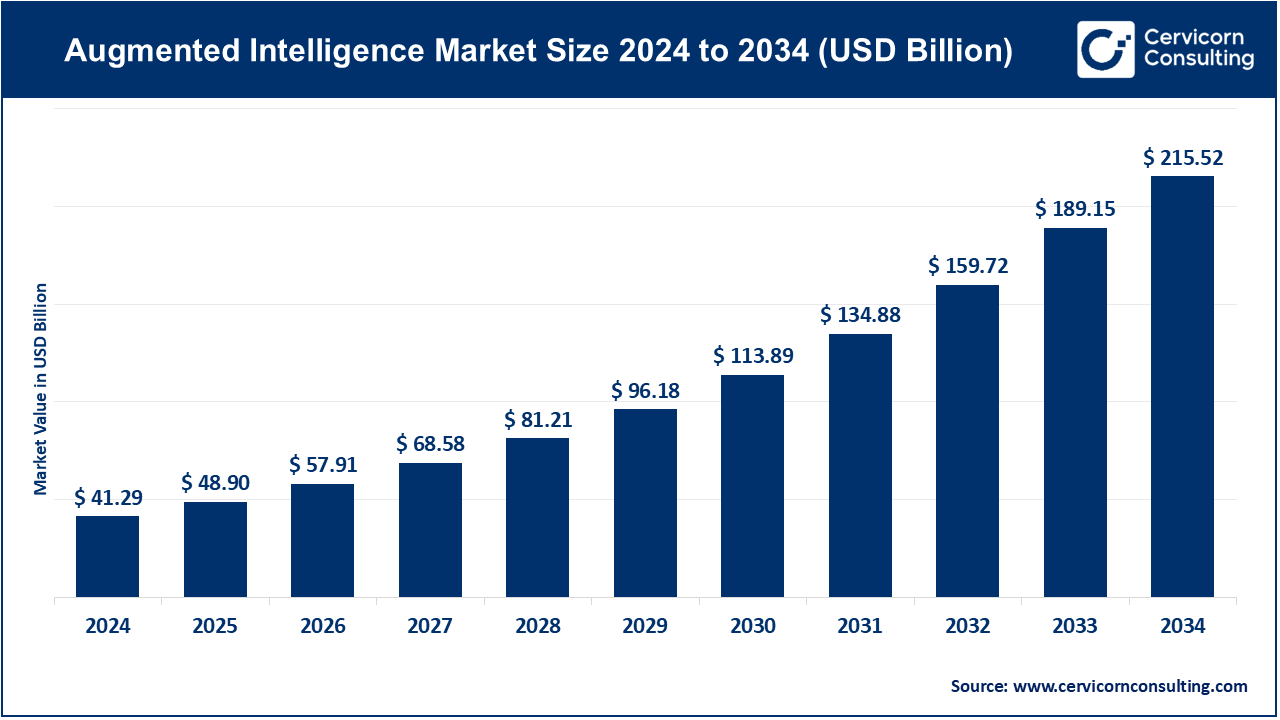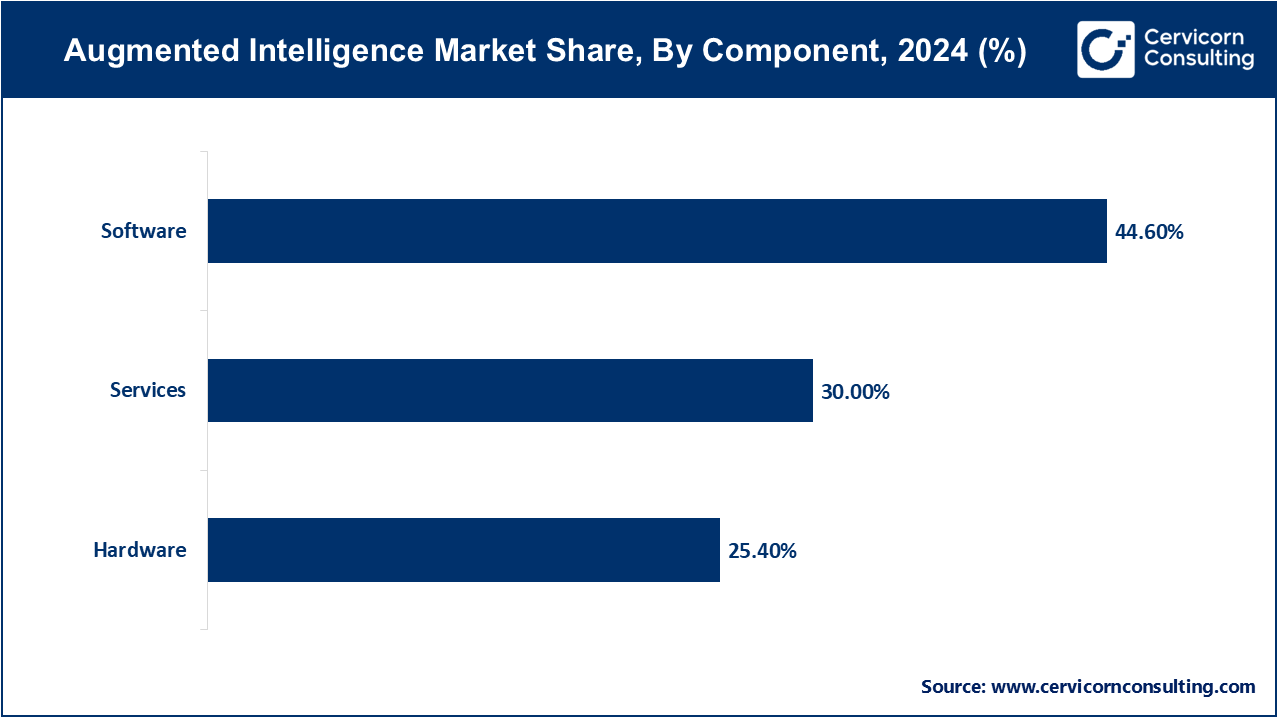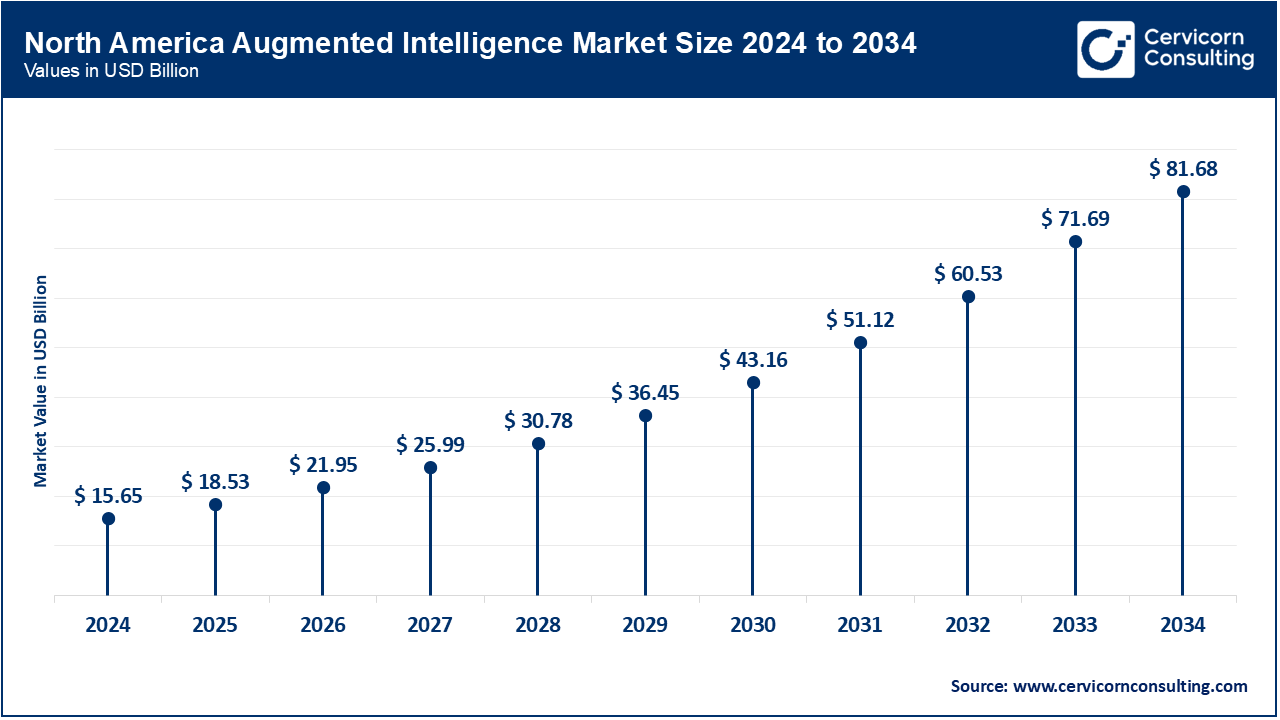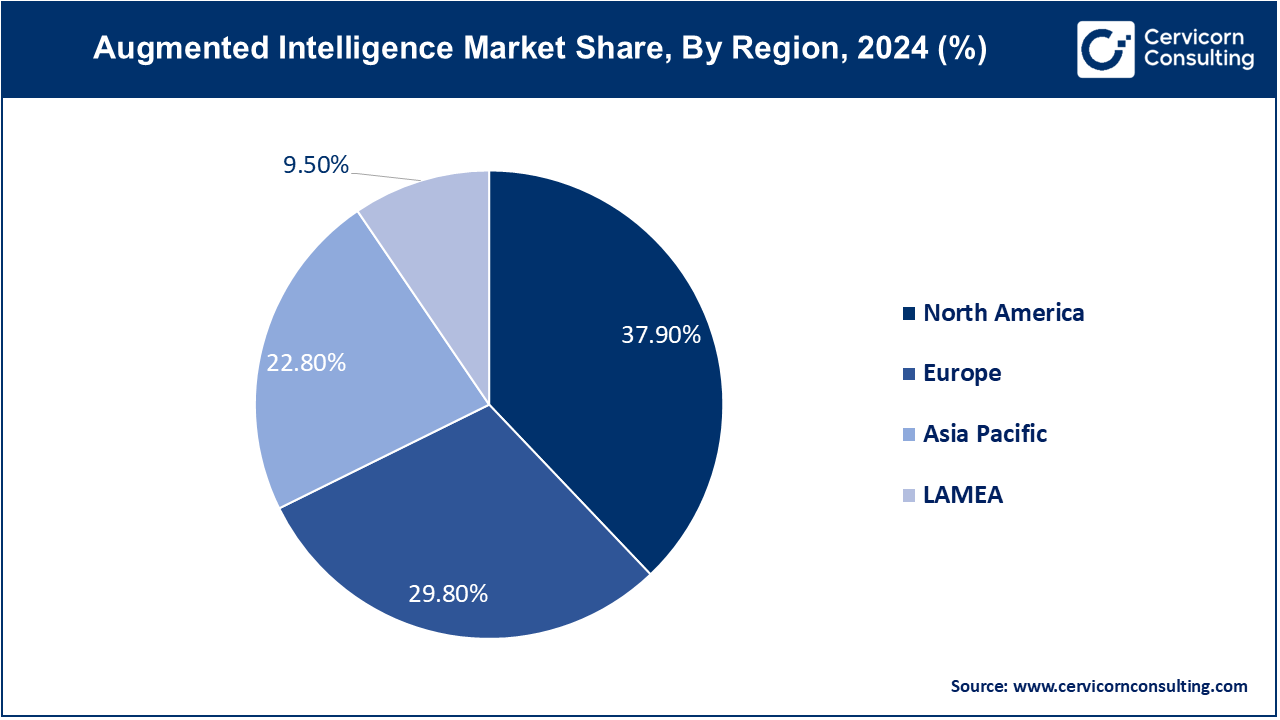The global augmented intelligence market size was worth USD 41.29 billion in 2024 and is expected to hit around USD 215.52 billion by 2034, growing at a compound annual growth rate (CAGR) of 17.97% from 2025 to 2034.
The augmented intelligence market is growing rapidly due to advancements in AI, increasing data availability, and demand for intelligent automation. Businesses are adopting AI-powered tools to improve decision-making, reduce errors, and enhance customer experiences. The integration of AI with cloud computing and IoT is further driving adoption. Industries such as healthcare and finance are leading the market expansion. AI-driven analytics in business intelligence and customer engagement are also fueling growth. As organizations recognize the benefits of augmented intelligence, its adoption is expected to rise significantly in the coming years.

The augmented intelligence market perfectly integrates technology into human endeavours with the purpose of optimizing choices, results, and synergy. Augmented intelligence solutions employ AI, machine learning and natural language processing in their primary workflow to support professionals working in healthcare, finance, retail and customer services markets. Augmenting intelligence is not about replacing expert decisions but support and enhance them by offering distinctive data driven advices. This market is comprised by diverse applications such as predictive analysis, decision making support system, intelligent process automation and recommendation system in order to assist a person to make better and effective decisions.
According to Frontiers, Augmented Intelligence (AI) development has undoubtedly allowed the coexistence with intelligent machines and has created specific types of interaction between humans and systems, in which humans enhance their capabilities for the decision-making process. All this has been crucial in shaping our present and future society; simultaneously, it has influenced the many challenges we have to cope with in searching for a smooth coexistence with intelligent systems. Many challenges are related to the lack of consideration for the accessibility and inclusion of diverse users, especially those traditionally marginalized or neglected, while conceptualizing products and systems that use AI as core features.
Augmented Intelligence is the use of AI to help humans make better decisions rather than replacing them. It works by analyzing large amounts of data and providing useful insights, predictions, and suggestions. This helps people work faster, make smarter choices, and improve accuracy. For example, in healthcare, AI helps doctors diagnose diseases by analyzing medical records. In finance, it predicts market trends to assist investors. Many businesses use augmented intelligence to improve customer service and decision-making. The main goal is to support human intelligence, making work more efficient and productive. Augmented intelligence is already a present reality, as many of the devices and services we use every day incorporate some form of AI technology to assist us. For example, we use voice assistants, such as Siri or Alexa, to search for information, control smart devices, or play music. We use navigation apps, such as Google Maps or Waze, to find the best routes, avoid traffic, or explore new places. We use social media platforms, such as Facebook or Instagram, to connect with friends, share content, or discover new interests.
According to Association for the Advancement of Medical Instrumentation, Augmented intelligence integrates human intelligence and machine-derived outputs to improve health. Sometimes a distinction is made between “general” artificial intelligence and “narrow” artificial intelligence, with the latter representing any algorithm designed to perform a single specified task. Almost every AI/ML-enabled medical application in development (of which I am aware) looks much more like a “narrow” AI tool than a “general” AI tool. Further, all of the AI/ML-enabled medical applications that have been deployed also fall into the category of narrow AI. That being said, until general artificial intelligence is within reach, narrow AI and the varied uses in healthcare and health technology can serve as an important means of scaling human capacity.
Key Insights Beneficial to the augmented intelligence market:
Report Scope
| Area of Focus | Details |
| Market Size in 2025 | USD 48.90 Billion |
| Expected Market Size (2034) | USD 215.52 Billion |
| Projected Growth Rate (2025 to 2034) | 17.97% |
| Dominating Region | North America |
| Fastest Growing Region | Asia Pacific |
| Segments Covered | Component, Technology, Deployment, Organization Size, Vertical, Region |
| Key Companies | IBM Corporation, Microsoft Corporation, Google LLC, AWS, Oracle Corporation, SAP SE, Salesforce, Inc., SAS Institute Inc., Intel Corporation, Hewlett Packard Enterprise (HPE), NVIDIA Corporation, Baidu, Inc., Siemens AG, Qualcomm Technologies, Inc., TIBCO Software Inc. and others |
The augmented intelligence market is segmented into component, technology, deployment type, organization size, vertical and region. Based on component, the market is classified into software, services and hardware; Based on technology, the market is classified into machine learning, natural language processing (NLP), computer vision, speech recognition and others. Based on deployment type, the market is classified into on-premise and cloud-based. Based on organization size, the market is classified into small and medium-sized enterprises and large enterprises. Based on vertical, the market is classified into IT and telecom, BFSI, healthcare, manufacturing, retail & consumer goods, energy & utilities, government and defence, automotive, agriculture and others.
Hardware: The hardware segment has accounted revenue share of 25.40% in 2024. AI hardware refers to servers, storage and networking hardware solutions that are required providing required computing capabilities. Such components enable fast data inputs handling and the model building, which is crucial for using AI.
Software: The software segment has genereted revenue share of 44.60% in 2024. This category has sophisticated applications of artificial intelligence such as software tools for analytic, Natural Language Processing, as well as predictive analysis. All these solutions provide insight, improve organizational performance and assist in decision making.

Services: The service segment has captured revenue share of 30% in 2024. It was noted that post-AI consulting, integration, and support services are the core in an effective flow of an AI implementation. Since it plays the role of guaranteeing, without hitches, sustained enhancement and backing for Augmented Intelligence solutions.
Machine Learning: This is a process by which systems are able to learn and have the ability to adjust data pattern without any prior coding. Linear regression model is used in virtually all forms of application including forecasts, pattern identification, decision making, and more.
Natural Language Processing (NLP): NLP enables computers to both comprehend human language as well as generate human language as well. Being applied in chatbots, sentiment analysis, automatic translation and sooner, it contributes to improving user interaction.
Computer Vision: Computer vision allows computers to understand content from the world through vision. This tech is also applicable for the following use cases, for example; object identification of images and videos, facial identification, and localization within self-driven automobiles.
Speech Recognition: It can translate speech to text and offer services in issues of voice commands devices, and transcription, making it easier for people to interact with their gadgets.
Cloud-Based: Conversely, cloud-hosted AI solutions are mobile and scalable platforms to help organizations expand with little capital investment. This may easily be increased at any given time through cloud hosting, to meet the desired capacity. This is particularly suitable for organisations that seeks to embark on fast and quick deployment.
On-Premises: As for the specific regulatory requirements or have weak security, on-premises deployment is truly perfect. This model’s highest level of data and system control is created, and stability and higher data privacy are also adopted.
The North America augmented intelligence market size was valued at USD 15.65 billion in 2024 and is expected to reach around USD 81.68 billion by 2034. As such, the opportunity in the North American market of augmented intelligence in the future will be accelerated as sectors such as finance and healthcare, as well as retail continue to embrace such advanced solutions. The tis region has well developed technology support structure complemented by a favourable regulatory environment that shall foster innovation.

The Europe augmented intelligence market size was estimated at USD 12.3 billion in 2024 and is expected to surpass around USD 64.22 billion by 2034. Favourable AI adoption and data protection regulatory frameworks have spurred a rapidly growing augmented intelligence market in Europe. Major adoptions have been seen across such verticals as manufacturing and automotive, whereby the technology appears to increase productivity and safety.
The Asia-Pacific augmented intelligence market was worth USD 9.41 billion in 2024 and is projected to reach around USD 49.14 billion by 2034. According to some, the Asia-Pacific region is expanding at a very rapid rate in the market of augmented intelligence. This is because the rapid digital transformation of companies from China, Japan, and South Korea the latest trend. As a result, health care, finance, and e-commerce industries invest considerable sums within augmented intelligence to be well-qualified about recent trends in the market.

The LAMEA augmented intelligence market size was accounted for USD 3.92 billion in 2024 and is anticipated to surpass around USD 20.47 billion by 2034. New business and investment opportunities lie in the growing industries including agriculture, energy and financial services. Sound foundations that can support investments in infrastructure technology and in the cultivation of digitally-based skills will be a driver of the growth of this market in these regions.
Innovation from not only emerging companies but established players is changing the scenario in this market: The growth of this market is backed by the progress made in AI & machine learning, improved data availability, and rising industry adoption rates. Other emerging players who are pushing the agenda include Narrative Science and AIBrain that are offering new solutions through improved algorithms to offer even more support.
Currently, Narrative Science is concentrated on turning data into narratives as a way of making it easier for professionals to gain further insight from such data. While AIBrain targets the development of purely robotic systems, which apply decision-making based on data analysis, cognitive reasoning and problem solving is used by AIBrain to provide human decision making with supporting AI tools in real-life applications.
CEO Statements
CEO, IBM Watson:
Chief Technology Officer, Google Cloud AI:
Vice President, Microsoft Azure AI:
Market Segmentation
By Component
By Technology
By Deployment Type
By Organization Size
By Vertical
By Region
Chapter 1 Market Introduction and Overview
1.1 Market Definition and Scope
1.1.1 Overview of Augmented Intelligence
1.1.2 Scope of the Study
1.1.3 Research Timeframe
1.2 Research Methodology and Approach
1.2.1 Methodology Overview
1.2.2 Data Sources and Validation
1.2.3 Key Assumptions and Limitations
Chapter 2 Executive Summary
2.1 Market Highlights and Snapshot
2.2 Key Insights by Segments
2.2.1 By Component Overview
2.2.2 By Technology Overview
2.2.3 By Deployment Type Overview
2.2.4 By Organization Size Overview
2.2.5 By Vertical Overview
2.3 Competitive Overview
Chapter 3 Global Impact Analysis
3.1 COVID 19 Impact on Augmented Intelligence Market
3.1.1 COVID-19 Landscape: Pre and Post COVID Analysis
3.1.2 COVID 19 Impact: Global Major Government Policy
3.1.3 Market Trends and Opportunities in the COVID-19 Landscape
3.2 Russia-Ukraine Conflict: Global Market Implications
3.3 Regulatory and Policy Changes Impacting Global Markets
Chapter 4 Market Dynamics and Trends
4.1 Market Dynamics
4.1.1 Market Drivers
4.1.1.1 Data-Driven Decision-Making Demand
4.1.1.2 Operational Efficiency
4.1.2 Market Restraints
4.1.2.1 High Implementation Costs
4.1.2.2 Data Privacy Concerns
4.1.3 Market Opportunity
4.1.3.1 Entry into New Markets
4.1.3.2 Industry-specific customization
4.1.4 Market Challenges
4.1.4.1 Talent Shortage
4.1.4.2 Integration with Legacy Systems
4.2 Market Trends
Chapter 5 Premium Insights and Analysis
5.1 Global Augmented Intelligence Market Dynamics, Impact Analysis
5.2 Porter’s Five Forces Analysis
5.2.1 Bargaining Power of Suppliers
5.2.2 Bargaining Power of Buyers
5.2.3 Threat of Substitute Products
5.2.4 Rivalry among Existing Firms
5.2.5 Threat of New Entrants
5.3 PESTEL Analysis
5.4 Value Chain Analysis
5.5 Product Pricing Analysis
5.6 Vendor Landscape
5.6.1 List of Buyers
5.6.2 List of Suppliers
Chapter 6 Augmented Intelligence Market, By Component
6.1 Global Augmented Intelligence Market Snapshot, By Component
6.1.1 Market Revenue (($Billion) and Growth Rate (%), 2022-2034
6.1.1.1 Software
6.1.1.2 Services
6.1.1.3 Hardware
Chapter 7 Augmented Intelligence Market, By Technology
7.1 Global Augmented Intelligence Market Snapshot, By Technology
7.1.1 Market Revenue (($Billion) and Growth Rate (%), 2022-2034
7.1.1.1 Machine Learning
7.1.1.2 Natural Language Processing (NLP)
7.1.1.3 Computer Vision
7.1.1.4 Speech Recognition
7.1.1.5 Others (Predictive Analytics, Spatial Navigation, Context-Aware Computing, Logical Reasoning and Pattern Recognition)
Chapter 8 Augmented Intelligence Market, By Deployment Type
8.1 Global Augmented Intelligence Market Snapshot, By Deployment Type
8.1.1 Market Revenue (($Billion) and Growth Rate (%), 2022-2034
8.1.1.1 On-premise
8.1.1.2 Cloud-based
Chapter 9 Augmented Intelligence Market, By Organization Size
9.1 Global Augmented Intelligence Market Snapshot, By Organization Size
9.1.1 Market Revenue (($Billion) and Growth Rate (%), 2022-2034
9.1.1.1 Small and Medium-sized Enterprises
9.1.1.2 Large Enterprises
Chapter 10 Augmented Intelligence Market, By Vertical
10.1 Global Augmented Intelligence Market Snapshot, By Vertical
10.1.1 Market Revenue (($Billion) and Growth Rate (%), 2022-2034
10.1.1.1 IT and Telecom
10.1.1.2 BFSI
10.1.1.3 Healthcare
10.1.1.4 Manufacturing
10.1.1.5 Retail & Consumer Goods
10.1.1.6 Energy & Utilities
10.1.1.7 Government and Defence
10.1.1.8 Automotive
10.1.1.9 Agriculture
10.1.1.10 Others
Chapter 11 Augmented Intelligence Market, By Region
11.1 Overview
11.2 Augmented Intelligence Market Revenue Share, By Region 2024 (%)
11.3 Global Augmented Intelligence Market, By Region
11.3.1 Market Size and Forecast
11.4 North America
11.4.1 North America Augmented Intelligence Market Revenue, 2022-2034 ($Billion)
11.4.2 Market Size and Forecast
11.4.3 North America Augmented Intelligence Market, By Country
11.4.4 U.S.
11.4.4.1 U.S. Augmented Intelligence Market Revenue, 2022-2034 ($Billion)
11.4.4.2 Market Size and Forecast
11.4.4.3 U.S. Market Segmental Analysis
11.4.5 Canada
11.4.5.1 Canada Augmented Intelligence Market Revenue, 2022-2034 ($Billion)
11.4.5.2 Market Size and Forecast
11.4.5.3 Canada Market Segmental Analysis
11.4.6 Mexico
11.4.6.1 Mexico Augmented Intelligence Market Revenue, 2022-2034 ($Billion)
11.4.6.2 Market Size and Forecast
11.4.6.3 Mexico Market Segmental Analysis
11.5 Europe
11.5.1 Europe Augmented Intelligence Market Revenue, 2022-2034 ($Billion)
11.5.2 Market Size and Forecast
11.5.3 Europe Augmented Intelligence Market, By Country
11.5.4 UK
11.5.4.1 UK Augmented Intelligence Market Revenue, 2022-2034 ($Billion)
11.5.4.2 Market Size and Forecast
11.5.4.3 UK Market Segmental Analysis
11.5.5 France
11.5.5.1 France Augmented Intelligence Market Revenue, 2022-2034 ($Billion)
11.5.5.2 Market Size and Forecast
11.5.5.3 France Market Segmental Analysis
11.5.6 Germany
11.5.6.1 Germany Augmented Intelligence Market Revenue, 2022-2034 ($Billion)
11.5.6.2 Market Size and Forecast
11.5.6.3 Germany Market Segmental Analysis
11.5.7 Rest of Europe
11.5.7.1 Rest of Europe Augmented Intelligence Market Revenue, 2022-2034 ($Billion)
11.5.7.2 Market Size and Forecast
11.5.7.3 Rest of Europe Market Segmental Analysis
11.6 Asia Pacific
11.6.1 Asia Pacific Augmented Intelligence Market Revenue, 2022-2034 ($Billion)
11.6.2 Market Size and Forecast
11.6.3 Asia Pacific Augmented Intelligence Market, By Country
11.6.4 China
11.6.4.1 China Augmented Intelligence Market Revenue, 2022-2034 ($Billion)
11.6.4.2 Market Size and Forecast
11.6.4.3 China Market Segmental Analysis
11.6.5 Japan
11.6.5.1 Japan Augmented Intelligence Market Revenue, 2022-2034 ($Billion)
11.6.5.2 Market Size and Forecast
11.6.5.3 Japan Market Segmental Analysis
11.6.6 India
11.6.6.1 India Augmented Intelligence Market Revenue, 2022-2034 ($Billion)
11.6.6.2 Market Size and Forecast
11.6.6.3 India Market Segmental Analysis
11.6.7 Australia
11.6.7.1 Australia Augmented Intelligence Market Revenue, 2022-2034 ($Billion)
11.6.7.2 Market Size and Forecast
11.6.7.3 Australia Market Segmental Analysis
11.6.8 Rest of Asia Pacific
11.6.8.1 Rest of Asia Pacific Augmented Intelligence Market Revenue, 2022-2034 ($Billion)
11.6.8.2 Market Size and Forecast
11.6.8.3 Rest of Asia Pacific Market Segmental Analysis
11.7 LAMEA
11.7.1 LAMEA Augmented Intelligence Market Revenue, 2022-2034 ($Billion)
11.7.2 Market Size and Forecast
11.7.3 LAMEA Augmented Intelligence Market, By Country
11.7.4 GCC
11.7.4.1 GCC Augmented Intelligence Market Revenue, 2022-2034 ($Billion)
11.7.4.2 Market Size and Forecast
11.7.4.3 GCC Market Segmental Analysis
11.7.5 Africa
11.7.5.1 Africa Augmented Intelligence Market Revenue, 2022-2034 ($Billion)
11.7.5.2 Market Size and Forecast
11.7.5.3 Africa Market Segmental Analysis
11.7.6 Brazil
11.7.6.1 Brazil Augmented Intelligence Market Revenue, 2022-2034 ($Billion)
11.7.6.2 Market Size and Forecast
11.7.6.3 Brazil Market Segmental Analysis
11.7.7 Rest of LAMEA
11.7.7.1 Rest of LAMEA Augmented Intelligence Market Revenue, 2022-2034 ($Billion)
11.7.7.2 Market Size and Forecast
11.7.7.3 Rest of LAMEA Market Segmental Analysis
Chapter 12 Competitive Landscape
12.1 Competitor Strategic Analysis
12.1.1 Top Player Positioning/Market Share Analysis
12.1.2 Top Winning Strategies, By Company, 2022-2024
12.1.3 Competitive Analysis By Revenue, 2022-2024
12.2 Recent Developments by the Market Contributors (2024)
Chapter 13 Company Profiles
13.1 IBM Corporation
13.1.1 Company Snapshot
13.1.2 Company and Business Overview
13.1.3 Financial KPIs
13.1.4 Product/Service Portfolio
13.1.5 Strategic Growth
13.1.6 Global Footprints
13.1.7 Recent Development
13.1.8 SWOT Analysis
13.2 Microsoft Corporation
13.3 Google LLC
13.4 Amazon Web Services (AWS)
13.5 Oracle Corporation
13.6 SAP SE
13.7 Salesforce, Inc.
13.8 SAS Institute Inc.
13.9 Intel Corporation
13.10 Hewlett Packard Enterprise (HPE)